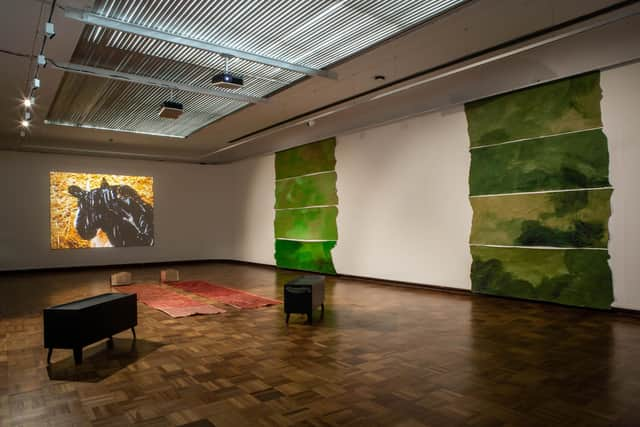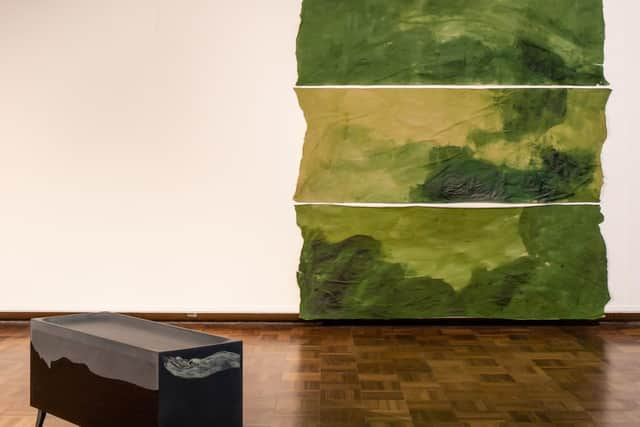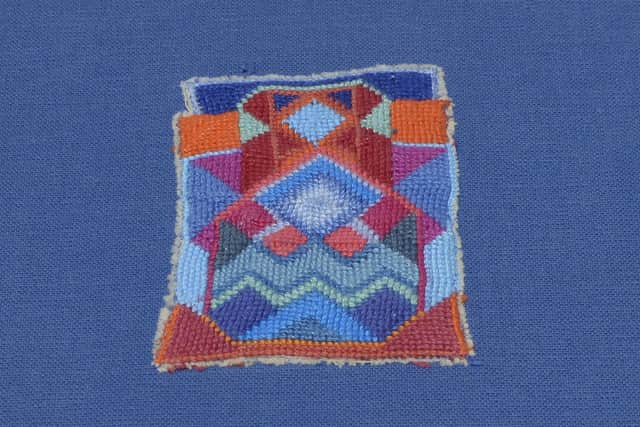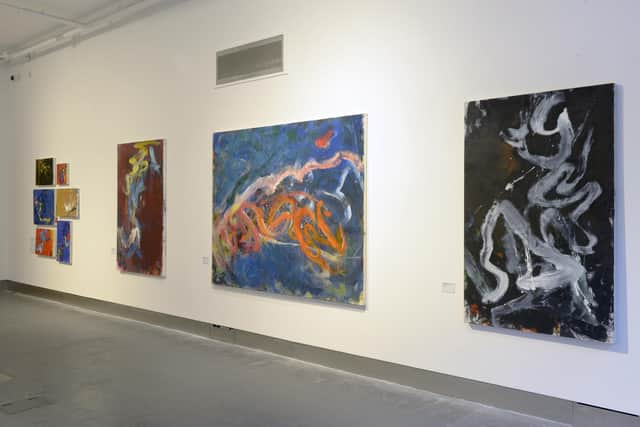Art reviews: Nashashibi/Skaer | Majd Abdel Hamid | Hock Aun Teh
Nashashibi/Skaer: Chimera, Cooper Gallery, Duncan of Jordanstone College of Art & Design, Dundee ****
Majd Abdel Hamid: Muscle Memory, CCA, Glasgow ***
Hock Aun Teh: Expanding Traditions, Reid Gallery, Glasgow School of Art ***
Advertisement
Hide Ad

Glasgow-trained artists Rosalind Nashashibi and Lucy Skaer have both made the leap from the local to the international art scene, meaning it’s comparatively rare to see their work in Scotland. However, as well as successful solo careers, they have a long-running collaborative practice which is a place of experimentation, dare I say, even play?
Their new show at Dundee’s Cooper Gallery has the feel of two artists letting their hair down. Structuring the show around three films they have made together (two of which have not been seen in the UK), they improvised the rest in the gallery: Nashashibi (best known as a filmmaker) painted on long strips of brown paper which are pinned on the wall and laid on the floor; Skaer added sculptural objects in a kind of formal jazz.
The 2019 film Lamb greets visitors in the lower gallery. Made in a lambing shed on a farm on the Isle of Lewis, it is raw and intimate. The lingering eye of the camera, characteristic of Nashashibi’s filmmaking, shows us ewes in labour, or encouraging shaky-legged new-born lambs to take their first steps. Accompanied by a soft, warbling score by composer Will Carslake and singer Olive Ray, it captures the fragility and resilience of new life, how routine it is, how remarkable, and how risky.
Bear, in the main gallery upstairs, was made in the same place during lockdown in 2021. This time, the artists, and digital animator Regina Ohak, impose images of bears on the sheep, a transformation which nods to the chimera of the show’s title. Both creatures, of course, come loaded with symbolic and mythic resonances: wild and tame; predators and prey.


The other works in the show create a kind of landscape around these: Skaer’s bronze Haystacks made of Garnet, Garnets made of Hay, and four-footed Slate Night sculptures, which immediately suggest the shape of sheep. Nashashibi’s strips of abstract painting are red/brown on the floor and green on the walls, a kind of landscape.
The outlier, here, is the 2009 film Our Magnolia, which freely associates ideas and images in the spirit of surrealism: Paul Nash’s portentous 1944 painting Flight of the Magnolia, images of Margaret Thatcher and looted museums in Iraq. It has a new impact now, with a Thatcher wannabe in Downing Street and the country in a kind of crisis no one foresaw in 2009. While the Lamb/Bear transition remains a conundrum, this is an intriguing and immediate show which speaks more to the current moment than perhaps anyone intended.
Advertisement
Hide AdMeanwhile, Majd Abdel Hamid continues the programme of international contemporary artists showing at CCA. He addresses a specific event and its aftermath: the catastrophic explosion in Beirut in 2020 which wiped out a third of the city and left 300,000 people homeless. One guesses that for Hamid, Palestinian-born and living between Beirut and Ramallah, this was a new catastrophe on top of existing traumas.
So what can art do? How can one grieve for a city which has been transformed (and was changing politically and economically even before the blast)? How can one heal from a loss which is hard to express?
Advertisement
Hide Ad

Hamid’s practice centres on embroidery, traditionally used in Palestine to celebrate different heritages and localities, and politicised after the intifada as a silent form of resistance. His work seeks to move it away from politics with bright colours and strong patterns, like tiny abstract paintings. The act of making is repetitive, meditative, potentially healing.
In the large central gallery, we see a range of these embroideries, many fragments and “sketches”, one or two larger ones, intense and detailed, their geometry perhaps hinting at street plans of the broken city. Two groups of polaroid photographs, one assumes of Beirut, feel delicate and elegiac.
The show begins and ends with durational films in which the artist tries wash pieces of embroidery which have been drenched with indigo dye (a bereavement tradition). Over and over, he soaps, scrubs, rinses, and the enterprise seems futile: while the water runs lilac, the colour is little changed. Only in the final room do we see the results of his labours, and see he did have partial success; the indigo is fainter, the original colours shining through.
As a show, it’s oddly balanced: tentative handmade works which feel like preparatory studies, but without the pay-off of a larger work resulting from all the preparation. That said, there is a powerful metaphor here about grief and trauma, and the gradual hard-won process of recovery.


There is nothing tentative about the work of Hock Aun Teh, Glasgow School of Art’s first Drawing and Painting graduate from Asia (in 1974), who still lives and works in the city. His works takes over the Reid Gallery with a storm of expressive energy; apart from some early sketches from art school days, the majority of these big, confident, colourful paintings were made in the last three years.
Born in Malaysia to Chinese parents, he trained in traditional Chinese ink painting before coming to Glasgow, where tutors like David Donaldson advised him: “Keep your tradition, but keep expanding on it.” His style draws on elements of Chinese calligraphy, bringing this together with Western abstract expressionist painting.
Advertisement
Hide AdBoth of these influences exert their pull. Some works, such as the long, narrow painting Indomitable Spirit, feel oriental. Sometimes a dash of colour shimmers in a painting like a fish or bird might in a traditional Chinese watercolour. Other pieces are expressionist in the Jackson Pollock way, colourful, instinctive, roiling with paint. Within this, he experiments: some works are richly layered with colour, one is almost completely white, another almost entirely black.
Titles such as Watching Tadpoles After The Morning Rain have a haiku-like quality. In Two Drunken Scots Singing and Dancing in the Street he uses short brush strokes which suggest street lights on rain-slicked cobbles. Some titles have a welcome touch of humour: Arguing is Bad for Your Sex Life; Falling Asleep on the Couch on a Sunday Afternoon.
Advertisement
Hide AdWhile many are full of raw, Pollock-like emotions, a few arrive at a zen-like calm: Remaining still and calm and Spiritual enlightenment both use a Chinese tonal palette, as do his works on the Four Seasons (another traditional Chinese subject). Yet even these are full of movement. There might be calm, but there is little stillness: Hock Aun Teh is an artist who can’t sit still.
Nashashibi/Skaer until 10 December; Majd Abdel Hamid until 11 November; Hock Aun Teh until 29 October